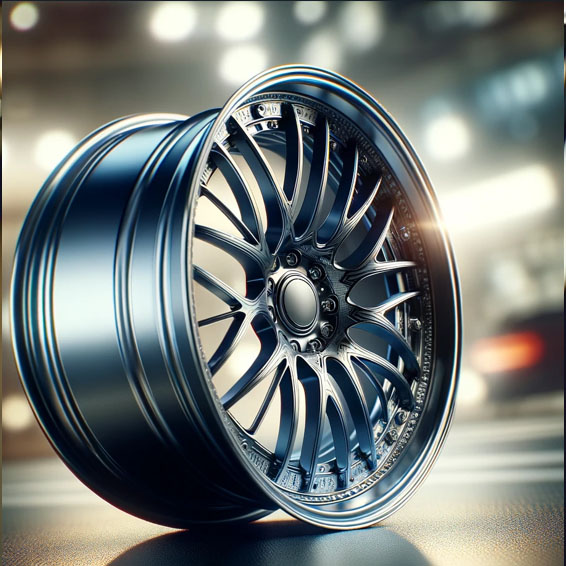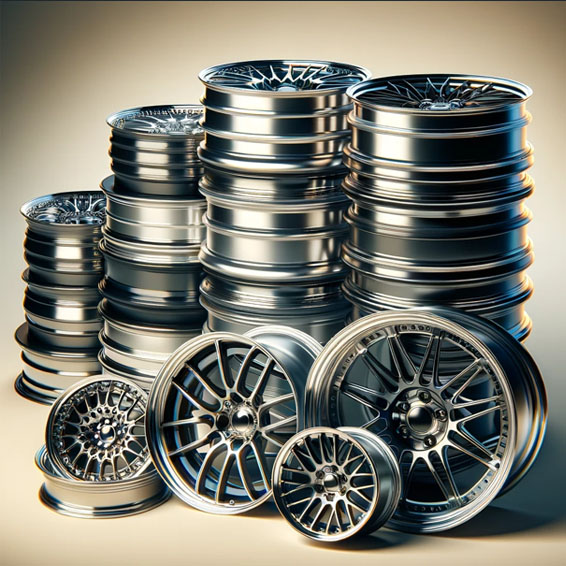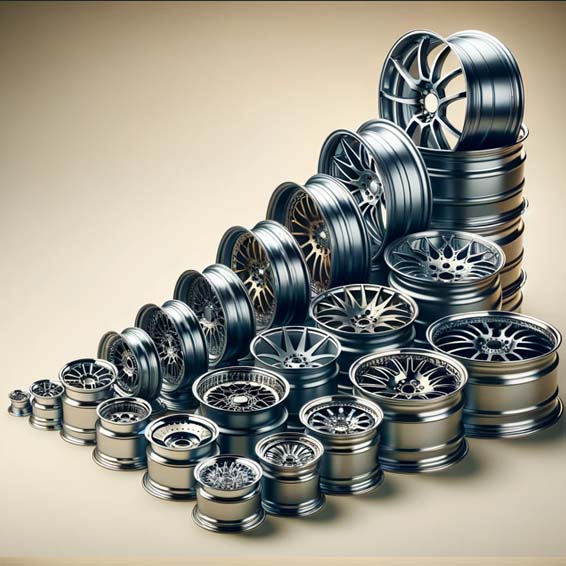The Weight of an aluminum rim can vary widely depending on its size, design, and specific use (e.g., automotive, motorcycle, bicycle). However, to give you a general idea:
How much does an Aluminum rim weight
Automotive Aluminum rims:

Passenger Cars:
Standard rim sizes range from 14 to 20 inches in diameter, with widths of 5.5 inches to 11 inches. Depending on size and construction, aluminum rim weight can vary widely from 7kg to 12kg.
Performance and Sports Cars:
These vehicles often use more extensive rims, up to 21 inches or more in diameter and 12 inches in width. Still, using advanced aluminum alloys and manufacturing techniques can keep aluminum rim weight comparable to smaller rims, generally in the 8kg to 12kg range.
Trucks and SUVs:
Rims for these vehicles can be more extensive and need to support more Weight, leading to heavier rims. Sizes can range from 15 to 22 inches or more, with aluminum rim weights from 10kg to over 20kg, depending on the size and design.
Motorcycle Aluminum rims:

Street Motorcycles:
Rim diameters range from 16 to 21 inches, with widths from 2.5 to 6 inches. These aluminum rim Weights are generally between 4kg to 6kg.
Off-Road Motorcycles:
These typically use lighter and smaller rims, often 18 to 21 inches in diameter but narrower than street motorcycles. Aluminum rim Weights are slightly lower, ranging from 3kg to 5kg.
Bicycle Aluminum rims:

Road Bikes:
Standard diameters include 700C (622mm) with widths from 15mm to over 25mm. Aluminum rim Weights can range from 300g to 500g per rim, depending on the width and design.
Mountain Bikes:
Diameters include 29 inches (622mm), 27.5 inches (584mm), and older 26 inches (559mm). Aluminum rim Weights for these rims can vary from 400g to 600g, with wider rims for off-road use being on the heavier end.
Type of Rims

Rims, also known as wheels, come in various materials and designs, each offering its own set of characteristics, benefits, and drawbacks. The type of rim you choose can significantly affect your vehicle’s appearance, performance, and handling. Here’s a rundown of the primary types of rims available:
Steel Rims
Characteristics:
Steel rims are made of pressed steel and are durable and robust. They’re often covered with a wheel cover or hubcap to improve appearance.
Benefits:
Cost-effective, durable, and can easily be repaired if bent. Ideal for harsh driving conditions and winter use.
Drawbacks:
Heavier than other types, which can impact fuel efficiency and handling. More aesthetically appealing with a cover.
Aluminum Alloy Rims
Characteristics:
Made from an alloy of aluminum and other metals, offering a good balance of strength and lightness. They come in various finishes and designs.
Benefits:
Lighter than steel, improving handling, fuel efficiency, and acceleration. It also offers better heat dissipation for brakes and is more aesthetically versatile. you can also find out Best Color Rims for A White Car in our previous article.
Drawbacks:
More expensive than steel rims and more susceptible to cosmetic damage like scratches and corrosion.
Magnesium Alloy Rims
Characteristics:
Made from magnesium alloy, these are lighter than aluminum rims and offer high performance.
Benefits:
Excellent strength-to-weight ratio, good heat dissipation, and often used in racing or high-performance vehicles for their performance benefits.
Drawbacks:
High cost and more prone to corrosion if damaged. Magnesium can also be flammable in certain conditions, requiring special care.
Carbon Fiber Rims
Characteristics:
Carbon Fiber Rims are made from carbon fiber-reinforced polymers and are at the cutting edge of lightweight wheel technology.
Benefits:
Incredibly light, offering the best performance in terms of handling and acceleration. They also have a unique, high-tech appearance.
Drawbacks:
Very expensive and difficult to repair. Primarily used in high-performance or luxury vehicles.
Chrome Rims
Characteristics:
It is not a separate rim material but a finish that can be applied to metal rims, most commonly on aluminum or steel.
Benefits:
Highly reflective and shiny appearance, famous for aesthetic modifications and show cars.
Drawbacks:
Chrome plating can chip and rust if not correctly maintained. It’s also more expensive than standard finishes.
Forged vs. Cast Rims
Forged and cast rims represent two primary methods for manufacturing rims, each with its characteristics, benefits, and drawbacks. Choosing forged and cast rims can significantly impact a vehicle’s performance, appearance, durability, and cost. Here’s a detailed comparison:
Forged Rims

Manufacturing Process:
Forging involves shaping the rim under high pressure and temperature. The metal (usually aluminum) is heated and formed into a wheel shape using massive presses. This process aligns the metal’s grain structure, making it denser and more robust.
Characteristics:
- Extremely strong and durable.
- Lighter than cast rims of the same size and design.
- Reduced Weight leads to better vehicle handling, acceleration, and fuel efficiency.
Benefits:
- Superior strength and durability make them less likely to crack or bend under impact or heavy stress.
- Improved performance due to reduced unsprung mass and rotational inertia.
- It can offer better fuel economy and faster acceleration.
Drawbacks:
- Higher costs due to the more labor-intensive manufacturing process and the use of more material.
- The selection of styles and sizes may be more limited than cast rims due to the complexity and cost of production.
Cast Rims

Manufacturing Process:
Casting involves pouring molten metal into a mold to form the rim. There are different casting methods, including gravity casting, low-pressure casting, and high-pressure die casting, each with varying levels of density and strength for the final product.
Characteristics:
- Generally heavier than forged rims.
- Offer a wide variety of designs and sizes due to the flexibility of the casting process.
- More prone to damage from impacts, such as potholes or curbs, than forged rims.
Benefits:
- Lower production costs make them more affordable for consumers.
- A greater variety of designs and finishes are available.
- Adequate strength and durability for standard driving conditions and applications.
Drawbacks:
- Heavier Weight can negatively affect vehicle handling, acceleration, and fuel efficiency.
- It has less strength and durability than forged rims, making them more susceptible to damage.
Choosing the Right Type:
Selecting the right rim type involves considering your vehicle’s performance needs, budget, driving conditions, and aesthetic preferences. Each type offers unique advantages that cater to different priorities: performance, durability, or style.
Different types according to aluminum rim weight

Aluminum rim sizes and weights can vary significantly depending on the application (e.g., cars, motorcycles, bicycles) and the specific requirements of the vehicle or performance expectations. Here’s a broad overview of different aluminum rim sizes and their typical weights across various applications:
how much does an 15 inch aluminum rim weight
A 15-inch aluminum rim can serve a wide range of vehicles, from compact cars to some SUVs and light trucks, offering a good balance between performance and aesthetics. The Weight of a 15-inch aluminum rim can vary depending on its width, the specific aluminum alloy used, and its design (such as the number of spokes or whether it’s a low-pressure cast, high-pressure cast, or forged rim). Here are some general details and typical weight ranges:
Typical Specifications for 15-inch Aluminum Rims:
Diameter:
15 inches (the measurement across the breadth of the rim).
Width:
It can vary, typically between 5.5 inches and 7 inches. The width affects the tire size that can be mounted on the rim.
Bolt Pattern:
Varies depending on the vehicle’s make and model. Common patterns include 4x100mm, 5×114.3mm, and others.
Offset:
It can range from high positive to low or even negative, influencing how the wheels sit relative to the vehicle’s body.
Center Bore:
The hole in the middle of the rim fits over the vehicle’s hub. Size varies by vehicle hub size.
Weight Range:
Typical Weight For a 15-inch aluminum rim, the aluminum rim Weight can generally range from 6 kg to 9 kg (approximately 13 to 20 pounds) per rim. This range accounts for different styles and manufacturing methods.
how much does an 16 inch aluminum rim weight
A 16-inch aluminum rim is commonly used across many vehicles, including compact cars, sedans, smaller SUVs, and crossovers. These rims are favored for improved handling characteristics and aesthetic flexibility without significantly compromising ride comfort. Here’s a closer look at the typical specifications and weight considerations for 16-inch aluminum rims:
Typical Specifications for 16-inch Aluminum Rims:
Diameter:
16 inches (the distance across the circular rim).
Width:
Commonly ranges from 6 inches to 7.5 inches but can vary depending on the vehicle and specific application.
Bolt Pattern:
It varies widely depending on the vehicle’s make and model. Patterns can include 4×100 mm, 5×114.3 mm, and others, corresponding to the arrangement and number of bolts.
Offset:
The distance from the centerline of the rim to the plane of the hub mounting surface can significantly affect vehicle handling and clearance. Offsets can vary from high positive, neutral to negative.
Center Bore:
The diameter of the central hole in the rim that fits over the hub of the vehicle. This size is specific to the car to ensure a proper fit on the hub.
Weight Range:
Typical Weight for A 16-inch aluminum rim Weight can weigh between 7 kg to 10 kg (approximately 15 to 22 pounds). This range considers variations in design, construction, and the specific alloy used.
how much does an 17 inch aluminum rim weight
A 17-inch aluminum rim is a popular choice for various vehicles, from sedans and hatchbacks to SUVs and light trucks, offering a good balance between performance, aesthetics, and comfort. These rims provide a larger contact patch for tires, improving grip and handling while allowing for larger brake components than smaller ones. Here’s an overview of the typical characteristics and weight considerations for 17-inch aluminum rims:
Typical Specifications for 17-inch Aluminum Rims:
Diameter:
17 inches (the overall height of the rim).
Width:
Usually ranges from 7 inches to 8.5 inches, accommodating a variety of tire widths for different performance or aesthetic needs.
Bolt Pattern:
Varied, such as 5×112 mm and 5×114.3 mm, among others, depending on the make and model of the vehicle. The bolt pattern is crucial for ensuring the rim fits appropriately on the car.
Offset:
Varies widely to match different vehicle designs and performance requirements. The offset affects how the rims and tires fit within the wheel wells.
Center Bore:
The diameter of the rim’s central hole must fit snugly over the vehicle’s hub to ensure proper mounting and balance.
Weight Range:
Typical Weight for A 17-inch aluminum rim Weight can weigh from 8 kg to 12 kg (approximately 17.6 to 26.4 pounds). This range can vary based on the manufacturing process, design, and the specific aluminum alloy.
how much does an 18 inch aluminum rim weight
An 18-inch aluminum rim is famous for many midsize and larger vehicles, including sedans, SUVs, and sports cars. These rims balance improved handling and aesthetic appeal, offering space for larger brake systems and enhancing the vehicle’s overall stance. However, moving to more giant rims can affect ride quality, so choosing an 18-inch rim is a consideration of both performance and style. Here’s a detailed look at the specifications and weight considerations for 18-inch aluminum rims:
Typical Specifications for 18-inch Aluminum Rims:
Diameter:
18 inches (the vertical distance across the rim).
Width:
Typically ranges from 7.5 inches to 9 inches but can vary based on the vehicle type and performance requirements.
Bolt Pattern:
Depends on the vehicle make and model, with common patterns including 5×112 mm, 5×120 mm, and others. The bolt pattern ensures the rim fits correctly on the vehicle’s hub.
Offset:
The offset can vary significantly to accommodate different vehicle designs, affecting how the wheels sit relative to the vehicle’s body. It’s crucial for proper wheel alignment and handling.
Center Bore:
The hole’s diameter at the rim’s center must match the vehicle’s hub size for a proper fit.
Weight Range:
Typical Weight for an 18-inch aluminum rim Weight can weigh between 9 kg and 14 kg (approximately 20 to 31 pounds). This variance is due to differences in manufacturing methods, design, and the specific aluminum alloy used.
how much does an 19 inch aluminum rim weight
A 19-inch aluminum rim caters to performance and luxury vehicles, including sports cars, performance sedans, and upscale SUVs. This size enhances the visual appeal of a car with a more aggressive stance and allows for the fitment of larger tires, which can improve grip and handling dynamics. However, as with any increase in rim size, there are trade-offs regarding ride comfort and potential vulnerability to road imperfections. Below are the key characteristics and typical weight considerations for 19-inch aluminum rims:
Typical Specifications for 19-inch Aluminum Rims:
Diameter:
19 inches (the outer edge-to-edge measurement).
Width:
Often ranges from 8 inches to 9.5 inches, accommodating wider tires for improved performance and aesthetics.
Bolt Pattern:
Specific to the vehicle make and model, with standard configurations including 5×112 mm and 5×120 mm, ensuring the rim fits securely to the vehicle’s hub.
Offset:
This dimension adapts to different vehicle styles and engineering specifications, influencing how the rims align with the vehicle’s body and affecting handling characteristics.
Center Bore:
The diameter of the rim’s central hub opening must match the vehicle’s hub size for a proper fit, which is critical for vehicle safety and performance.
Weight Range:
Typical Weight for a 19-inch aluminum rim typically weighs 10 kg to 15 kg (approximately 22 to 33 pounds). This range accounts for variations in the rim’s design, the aluminum alloy used, and the manufacturing process.
Selecting the appropriate 19-inch rims requires attention to detail regarding vehicle specifications, including compatibility with the vehicle’s bolt pattern, offset, and center bore. Consulting with a professional or referring to the vehicle manufacturer’s recommendations can ensure the rims effectively enhance the vehicle’s performance and appearance.
how much does an 20 inch aluminum rim weight
A 20-inch aluminum rim is often found on high-performance sports cars, luxury sedans, and premium SUVs. This size is chosen for its significant impact on a vehicle’s aesthetics and performance. It offers a striking visual presence and the capacity for further improved handling characteristics due to wider tires. However, the larger diameter also means less tire sidewall, affecting ride comfort and increasing the risk of rim damage from road imperfections. Here’s an overview of the typical characteristics and considerations for 20-inch aluminum rims:
Typical Specifications for 20-inch Aluminum Rims:
Diameter:
20 inches (the outermost edge measurement).
Width:
Commonly ranges from 8.5 inches to 10 inches or more to accommodate wide tires that provide better traction and handling.
Bolt Pattern:
Depends on vehicle make and model, with variations such as 5×112 mm, 5×120 mm, etc., ensuring a proper fit to the vehicle’s hub.
Offset:
Varies significantly to fit different vehicle designs and performance aims, impacting how the wheels sit relative to the vehicle’s body.
Center Bore:
The diameter of the hole in the center of the rim that fits over the vehicle hub. It must match precisely for proper fitting.
Weight Range:
Typical Weight for a 20-inch aluminum rim Weight can weigh between 11 kg to 16 kg (approximately 24 to 35 pounds), influenced by its design, the type of aluminum alloy used, and the manufacturing process.
When considering upgrading to or replacing 20-inch aluminum rims, it’s essential to ensure compatibility with your vehicle’s specifications, such as bolt pattern, offset, and center bore. Additionally, be mindful of the potential impact on ride quality and tire choices. Consulting with a professional or referring to the vehicle manufacturer’s recommendations can help select rims that enhance your vehicle’s look and performance.
how much does an 21 inch aluminum rim weight
A 21-inch aluminum rim represents the upper echelon of wheel sizes commonly found on premium vehicles, including high-performance sports cars, luxury sedans, and upscale SUVs. These rims are selected for their dramatic impact on a vehicle’s aesthetics, offering an imposing and aggressive look that complements such vehicles’ luxurious or sporty nature. Additionally, the larger size allows for improved handling characteristics through wider tires and can accommodate larger brake systems for enhanced stopping power. Here’s what you should know about the typical characteristics and considerations for 21-inch aluminum rims:
Typical Specifications for 21-inch Aluminum Rims:
Diameter:
21 inches (the outer edge measurement).
Width:
Typically ranges from 9 to 11 inches, designed to accommodate wide, high-performance tires for better grip and stability.
Bolt Pattern:
Specific to the vehicle make and model, configurations such as 5×112 mm, 5×120 mm, etc., are crucial for ensuring the rims fit correctly on the vehicle’s hub.
Offset:
This measurement can vary widely to suit different vehicle designs and engineering requirements, influencing how the wheels align with the vehicle’s body and affect handling.
Center Bore:
The diameter of the rim’s central hub opening must match the vehicle’s hub size for a correct and safe fit.
Weight Range:
Typical Weight for a 21-inch aluminum rim Weight can weigh between 12 kg and 17 kg (approximately 26 to 37 pounds). The Weight is influenced by factors such as the manufacturing method, the rim’s design, and the specific aluminum alloy used.
Factors Influencing Weight:
Manufacturing Process:
Forged rims are typically lighter and more robust but more costly than cast rims. The specific casting technique (e.g., low-pressure or gravity casting) also plays a role in determining the Weight.
Design:
The structural design, including the number of spokes and the overall thickness, impacts the rim’s Weight. Heavier designs often offer a more distinctive style at the expense of increased Weight.
Alloy Composition:
Aluminum alloys are chosen for their balance of strength and lightness, but different alloys have varying densities and strength characteristics, affecting the overall Weight of the rim.
Conclusion
In summary, aluminum rims offer a blend of performance, aesthetics, and efficiency benefits, making them a popular choice for many drivers. We also check on how much an aluminum rim weight.
However, these advantages come at the cost of higher price points, potential for damage, and maintenance considerations. When choosing rims for a vehicle, it’s essential to weigh these pros and cons against your personal needs, preferences, and driving conditions to make the best decision.

